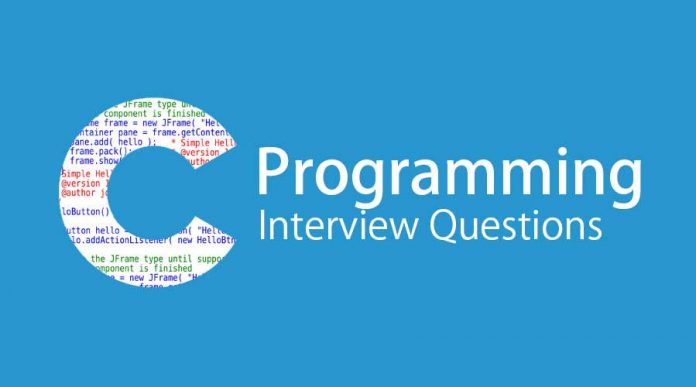Interview Questions For C: Most Asked Question In Interview
Interview Questions For C: Set 1
C introduced many core concepts and data structures like arrays, lists, functions, strings, etc. Many languages designed after C are designed on the basis of C Language. Hence, it is considered as the mother of all languages.
The main features of C language are given below:
Simple: C is a simple language because it follows the structured approach, i.e., a program is broken into parts
Portable: C is highly portable means that once the program is written can be run on any machine with little or no modifications.
Mid Level: C is a mid-level programming language as it combines the
low- level language with the features of the high-level language.
Structured: C is a structured language as the C program is broken into parts.
Fast Speed: C language is very fast as it uses a powerful set of data types and operators.
Memory Management: C provides an inbuilt memory function that saves memory and improves the efficiency of our program.
Extensible: C is an extensible language as it can adopt new features in the future.
The program will be compiled but will not be executed. To execute any C program, main() is required.
Global variables are declared outside any function, and they can be accessed (used) on any function in the program. Local variables are declared inside a function and can be used only inside that function. It is possible to have local variables with the same name in different functions. This one most important Interview Questions For C
In Call by value, a copy of the variable is passed whereas in Call by reference, a variable itself is passed. In Call by value, actual and formal arguments will be created in different memory locations whereas in Call by reference, actual and formal arguments will be created in the same memory location.
calloc() and malloc() are memory dynamic memory allocating functions. The only difference between them is that calloc() will load all the assigned memory locations with value 0 but malloc() will not.
In the case of static memory allocation, memory is allocated at compile-time, and memory can’t be increased while executing the program. It is used in the array.
The lifetime of a variable in static memory is the lifetime of a program.
The static memory is allocated using the static keyword.
The static memory is implemented using stacks or heaps.
The pointer is required to access the variable present in the static memory.
The static memory is faster than dynamic memory.
In static memory, more memory space is required to store the variable.
In the case of dynamic memory allocation, memory is allocated at runtime and memory can be increased while executing the program. It is used in the linked list.
The malloc() or calloc() function is required to allocate the memory at the runtime.
An allocation or deallocation of memory is done at the execution time of a program.
No dynamic pointers are required to access the memory.
The dynamic memory is implemented using data segments.
Less memory space is required to store the variable.
Accessing array elements: Pointers are used in traversing through an array of integers and strings. The string is an array of characters that is terminated by a null character ‘\0’.
Dynamic memory allocation: Pointers are used in allocation and deallocation of memory during the execution of a program.
Call by Reference: The pointers are used to pass a reference of a variable to other functions.
Data Structures like a tree, graph, linked list, etc.: The pointers are used to construct different data structures like tree, graph, linked list, etc. This one most important Interview Questions For C
NULL is used to indicate that the pointer doesn’t point to a valid location. Ideally, we should initialize pointers as NULL if we don’t know their value at the time of declaration. Also, we should make a pointer NULL when memory pointed by it is deallocated in the middle of a program.
A local static variable is a variable whose life doesn’t end with a function call where it is declared. It extends for the lifetime of the complete program. All calls to the function share the same copy of local static variables. Static variables can be used to count the number of times a function is called. Also, static variables get the default value is 0. For example, the following program prints “0 1”
#include <stdio.h>
void fun()
{
// static variables get the default value as 0.
static int x;
printf("%d ", x);
x = x + 1;
}
int main()
{
fun();
fun();
return 0;
}
// Output: 0 1
C support only 2 loops:
1.Entry Control: This loop is categorized in 2 part
1.1 while loop
1.2 for loop
2.Exit control: In this category, there is one type of loop known as
2.1 do-while loop.
1) The expression ‘i++’ returns the old value and then increments i. The expression ++i increments the value and returns the new value.
2) The precedence of postfix ++ is higher than that of prefix ++.
3) Associativity of postfix ++ is left to right and associativity of prefix ++ is right to left.
4) In C++, ++i can be used as l-value, but i++ cannot be. In C, they both cannot be used as l-value.
1. The structure used to link the operating system to a program is a file.
2. The file is defined in the header file “stdio.h”(standard input/output header file).
3. It contains the information about the file being used, its current size and its location in memory.
4. It contains a character pointer that points to the character that is being opened.
5. Opening a file establishes a link between the program and the operating system about which file is to be accessed.
Typecasting is a process of converting one data type into another is known as typecasting. If we want to store the floating type value to an int type, then we will convert the data type into another data type explicitly. This one most important Interview Questions For C
Syntax:
1
(type_name) expression;
The break Control statement is valid to be used inside a loop and Switch control statements.
Int data type is only capable of storing values between – 32768 to 32767. To store 32768 a modifier needs to used with the int data type. Long Int can use and also if there are no negative values, unsigned int is also possible to use.
1. To get the address of a variable
2. For achieving pass by reference in C: Pointers allow different functions to share and modify their local variables.
3. To pass large structures so that a complete copy of the structure can be avoided.
4. To implement “linked” data structures like linked lists and binary trees.
#include <stdio.h>
int main(void)
{
if (printf("Hello World")) {
}
}
Pointers are used for storing the address of dynamically allocated arrays and for arrays which are passed as arguments to functions. In other contexts, arrays and pointer are two different things.
Check out the Latest Jobs for C Developer: Link
Join WhatsApp and Telegram groups for daily job updates: Link
Prepare for Technical Round with Interview Questions: Link
Get insights into HR Interview Questions: Link
Craft a standout resume for Quick shortlisting: Link
Assessment with a Mock Test: Link
Mock Test with Aptitude and Coding Assessment: Click Here
Understand the Recruitment Process, Test, and Exam Pattern: Link
Explore Global Opportunities for Professionals & Freshers Abroad: Link
TCS NQT 2023 Careers: Graduate Trainee Hiring: Link
PwC Internships 2023: Opportunities in Zurich, Switzerland: Link
Chandrayaan 3: India’s Upcoming Lunar Mission Expectations: Link























